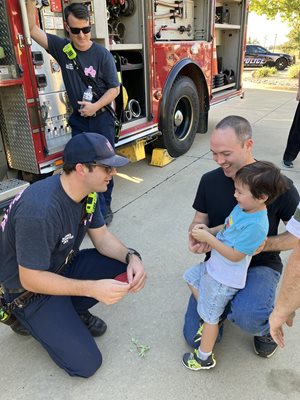But what are committees without volunteers? And how do you recruit volunteers who are eager to pitch in their unique skills to reach a common goal? The secret: It all starts with the committees themselves. Let's take a closer look at committee guidelines in Texas associations, exploring how committees are formed and the invaluable roles they play in their respective communities.

What does a HOA or COA committee do?
HOA or COA committees tackle a multitude of tasks, freeing up valuable time for board members like you. Effective committees serve as advisors to the board, providing valuable information, assessing problems, and coming up with solutions that ensure the well-being of the community.
Look at it this way: In every association, board members bring different skills and experience to the table. They also juggle their volunteer responsibilities with family, work, hobbies, and other commitments. Even if an association has a solid property management company handling the day-to-day operations, board members still have their fair share of responsibilities to their communities. This is where committees step in - to help balance the workload and offer expertise on specific topics, representing the community at large.
While the purpose of committees is to help the board make informed decisions, it's important to note that committee members generally don't have the final say in decision-making. That is still one of the Board of Directors' responsibilities. However, committees make these final decisions easier, and provide a "checks and balances" process for the board.
What are typical board committees?
Committees vary based on your community’s needs. Each serves a different purpose. Here are a few of the most common ones in Texas associations:
Social Committee: This committee's mission is to bring the community together by organizing exciting and engaging events. From back-to-school bashes to special holiday celebrations, to wine tastings, to seasonal festivals, members strive to create enjoyable experiences that foster neighborly connections.
This committee plays such an important role in bringing residents together, which is why some associations have an entire lifestyle program on-site dedicated to planning community events.
Learn more about how to throw successful events at any budget no matter the size of your HOA or COA.
Pictured below: Margaritaland Night at Union Park in Little Elm, Texas

Architectural Control Committee (a.k.a. Architectural Review Committee): Before a homeowner can start any major home improvement project, construct any architectural additions, or make any alterations, he/she must submit a formal request to the architectural committee. ACC/ARC members carefully review the request to ensure changes comply with the association's architectural standards.
Learn more about Texas HOA architectural committee guidelines - plus see the ultimate review checklist - here.
Financial Committee: With specialized sub-committees focused on finances, budgeting, reserves, and investments, they provide effective oversight for monthly performance monitoring, the implementation of annual budgets and reserve study recommendations, as well as investment policies.
Safety Committee: This committee actively works towards creating a secure environment by collaborating with local law enforcement and introducing preventive measures like neighborhood watches or citizen-on-patrol programs. It's important to note that they play a supportive role rather than that of enforcers, so we avoid using the term "security committee."
Landscape Committee: Members are dedicated to preserving and enhancing the natural beauty of the neighborhood. They focus on the aesthetics and sustainability practices employed to ensure the longevity of our green spaces.
Covenants Committee: Oversees the enforcement of the association’s CC&Rs, the most important and legally binding of all the governing documents.
Communications Committee: Keeping everyone in the loop is their priority. They ensure that all residents are up to date with the association's news and events through regular newsletters, a user-friendly website, and a variety of other platforms.
Other committees that are common in Texas associations include: Advisory Committee, Election Committee, and Welcome Committee.
Types of HOA and COA committees:
- Executive – comprised of board members only
- Standing – long-term committees, like finance or landscaping, that meet regularly and handle ongoing tasks
- Ad hoc/special – short-term committees that meet over a singular issue, dissolving once their goal is achieved

HOA and COA committee guidelines: how to form a committee in 5 steps.
-
Start with your association’s governing docs.
HOA and COA committees are normally established by the Board of Directors, so start with your governing documents to check for any homeowners or condo associations committees’ guidelines. Bylaws that outline rules regarding committee size, qualifications for members, and procedures for removing members may have already been added in the past. If these guidelines exist, it's important to adhere to them when setting up a committee.
-
Create the committee charters.
If there are no existing committee guidelines, the board should create committee charters. Each committee should have a charter that clearly states the committee's mission statement, budget, HOA or COA committee roles and responsibilities, decision-making authority, expense limitations, and scope of power. The charter may also include a timeframe for the committee's duration. You can use a committee charter template and personalize it for each committee you plan to establish.
-
Set up the structure for each HOA or COA committee.
Like the board, each committee should have an organizational structure, including these roles:
- Committee chair - handles meetings from start to end, sends out agenda before meetings.
- Committee secretary - writes and publishes the meeting minutes.
Under Texas law, each committee must have at least two members, most of whom should be board members. HOA or COA committees usually range from two to seven members, depending on the tasks at hand. Typically, board members on committees fulfill the role of chair or point person.
Open or closed meetings? Members must determine if committee meetings will be open or closed to other community members. It’s preferable for meetings to be open so they’ll engage more homeowners, however, it’s best for meetings over confidential matters to be closed (think: advisory committee and disciplinary committee).
-
Define job descriptions for committee members.
The board should create clear job descriptions for committee members to ensure everyone understands his/her role and responsibilities. Detailed and specific job descriptions help prevent misunderstandings and conflicts between board members, committee members, and homeowners.
-
Recruit residents to volunteer for committees.
With your committee structure and job descriptions in place, it’s time to rally residents to volunteer as committee members! Encouraging homeowners to join committees is an excellent way to engage them in community matters and bring fresh perspectives to the board.
Aside from skill requirements, consider certain character qualifications for committee members. While someone may be highly capable, having a respectful and friendly personality is equally important in maintaining a harmonious environment.
-a mission
-a strong leader
-clear goals
-a carefully crafted plan
-roles and responsibilities described in detail
Asking for volunteers: 4 ways to recruit residents.
By following the HOA and COA committee guidelines spelled out above, you're well on your way to attracting the right volunteers for each committee. However, recruiting residents to fill your HOA or COA committees’ volunteer openings won’t happen overnight. To help ease this process, we’ve put together four ways to recruit and retain great committee volunteers. Note: Feel free to tweak these strategies to fit your community's unique culture and needs.-
Promote more, in more places.
Do you ever feel like you might be asking for volunteers too often? Are you only using one or two platforms to ask, for example, just announcing committee openings at meetings or posting signs on community bulletin boards? While these are great ways to promote volunteer opportunities, it’s better to diversify announcement strategies. Homeowners who may not attend meetings or pass by those bulletin boards may not even know you need volunteers. Some may gladly step up if they were aware of the committee openings in the first place.
Other places to promote volunteer opportunities:- community newsletter
- community website
- interactive emails
- eye-catching flyers in more communal areas (like mailboxes and amenity centers)
- volunteer fair - plan within your community
-
Get close and personal.
Encourage residents to get involved by asking for suggestions and ideas. This gives them a sense of personal ownership, making them more inclined to join a committee that appeals to their interests. Surveys can serve as a great tool to gather ideas from homeowners. For example, email residents a short survey using simple platforms like JotForm or Google Forms. This gives you a clearer picture of how many homeowners want to find ways to serve the community and what committees would be the best fit for them.
Also, homeowners are more likely to engage if they know at least a few of the other volunteers. Joining a committee can be intimidating when everyone feels like a stranger. Consider hosting creative activities such as holiday parties, casino nights, ice cream socials (or even goat yoga!) to foster connections among residents. You can even use free online tools like SignUpGenius or VolunteerSpot to streamline the signup process.
The easier it is for homeowners to get involved, the more likely they are to volunteer.
Below: Community Luau at Harvest by Hillwood Communities in Argyle, Texas

-
Make it matter, and make it easy.
No resident wants to be left feeling like volunteering is a waste of his/her time. Be respectful of every volunteer’s time and provide an easy-to-understand plan for every committee role. As mentioned earlier in the HOA or COA committee guidelines, provide detailed descriptions - include specific dates, times, and the number of hours required. Also, mention the type of activities volunteers will be involved in, and point out any expertise or skills that could come in handy. This way, residents will know exactly what they're signing up for, making it easier for them to decide if a certain position is a good fit.
Don’t forget to provide answers to a few frequently asked questions too. Anticipating these questions will help put our residents' concerns at ease so they can feel good about joining a committee.
-
The most important part: thanking your volunteers.
Although residents volunteer to make a positive impact in their community, those who graciously offer their time still appreciate recognition. Seize every opportunity to praise the efforts of your HOA or COA board members and committee volunteers. Here are a few creative, meaningful ways to say “thank you”:- Formally recognize each volunteer’s contributions during meetings, in community newsletters, or on your association’s website.
- Never underestimate the power of a simple handwritten thank you card.
- Start a "Volunteer of the Month" program to honor those who have made a specific positive impact on your community members.
- Plan an annual volunteer appreciation dinner or even a small breakfast with coffee and donuts.
- Present annual awards. These can be as simple as certificates of volunteer participation or go the extra mile with additional awards like "most hours volunteered," “spirit of volunteerism,” or "volunteer of the year."
- Don't forget to acknowledge volunteers who take on smaller tasks or consistently provide support. Not only will your current volunteers feel valued, but other residents will also be more motivated to participate when they see that the work is genuinely appreciated.
- Be sure to thank your vendors and local community officials, too, who support committees in getting the job done.
Below: Local fire department visits Paloma Creek in Little Elm, Texas.
Conclusion
The success of any committee in your Texas association depends on the committee members themselves. That's why it's so important to use these HOA and COA committee guidelines as a foundation when establishing committees in the first place. Well-organized committees attract quality volunteers who can feel good knowing they're enhancing their community for fellow residents. Volunteerism creates transparency and accountability between the association and homeowners, fostering a stronger, more engaged community. Plus, residents who serve as committee members gain valuable training to be community leaders themselves in the future.
If you’re interested in expanding volunteer opportunities within your association, reach out to us today. We’d love to learn more about your current volunteers and explore the committees on which they serve.
Interactive all-in-one guide:
For quick visual summary of everything you've learned here about Texas HOA and COA committees, click below to open the interactive guide: "How to Form a Committee in 5 Steps."

FirstService Residential is simplifying property management.
Our FirstService Residential Texas family enjoys peace of mind knowing they’re in good hands. They can count on our 24/7 customer service for tailored solutions that take the balancing act out of property management. And our service-first philosophy means we don’t stop until what’s complicated becomes uncomplicated. To make life, simplified.If your association is not currently managed by FirstService Residential Texas, we would love to learn more about your community. Please click below and fill out a short Request for Proposal to set up a no-strings-attached conversation about how we can best support your association. We look forward to meeting you!